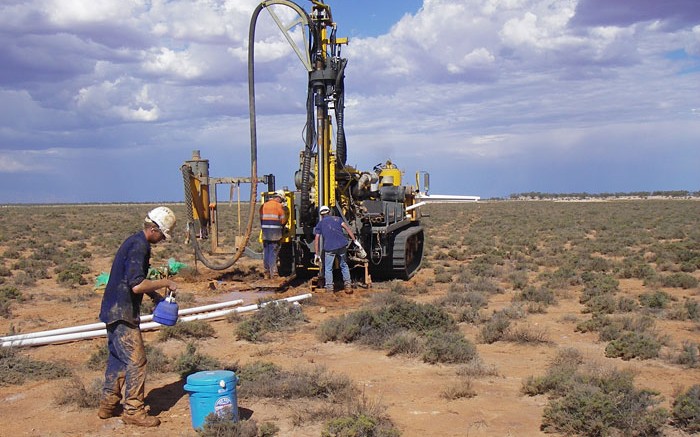VANCOUVER — Rockgate Capital (RGT-T) and Mega Uranium (MGA-T) are merging to create a uranium company with several advanced projects, early stage properties, a healthy treasury and a strong team of managers and directors.
The proposed merger would see Rockgate investors receive 2.2 Mega shares for each Rockgate share held, following a 1-to-10 consolidation of Mega shares. The post-consolidation exchange ratio implies a Rockgate share price of 25¢, which represents a 36% premium to the company’s 20-day, volume-weighted average. After the deal closes former Rockgate shareholders would own 49% of the combined company, with Mega investors holding the other 51%.
“This transaction represents the opportunity to combine one of Africa’s most promising undeveloped uranium assets with our significant Australian portfolio, to create an international uranium developer,” says Sheldon Inwentash, Mega’s CEO.
The African asset in question is Falea, Rockgate’s flagship property. Located in southwestern Mali, Falea covers 225 sq. km and hosts a uranium-copper-silver deposit that is the focus of a prefeasibility study.
Falea’s resource stands at 15.7 million measured and indicated tonnes grading 0.086% uranium oxide (U3O8), 55 grams silver per tonne, and 0.22% copper, plus 15.4 million inferred tonnes averaging 0.05% U3O8, 18 grams silver and 0.24% copper. Rockgate is drilling at the site with a 6,000-metre drill program underway targeting a satellite zone that could add to the overall resource.
The prefeasibility study will replace an initial Falea study that assumes conventional acid leaching to recover uranium. However, high carbonate content means that Falea’s rocks would consume a lot of reagent, which is an expensive proposition. Over the last two years, Rockgate has also confirmed copper and silver at Falea.
To recover by-products and reduce processing costs, Rockgate had to rethink its plans. Extensive metallurgical tests led the company to a new flow sheet that starts with floating the mineralized material to separate the copper and silver sulphides, followed by acid leaching. The uranium-bearing carbonate concentrate would be processed separately using an alkaline leach.
The new prefeasibility study based on this flow sheet was expected by October, but last year’s coup d’état in Mali and the associated insurgency in the country’s north delayed work at Falea, which is located in southwestern Mali. The study is now due in December. A draft uranium convention for the country that was to be presented to parliament in April 2012 has also been in limbo since the coup. Rockgate expects the convention to be enacted as a decree after Mali’s general elections, which are taking place in July.
Adding Falea would diversify Mega’s portfolio, which focuses on Australia and Canada. Mega’s three main uranium projects are in Australia, where it also owns part or all of five other properties. The largest and most advanced of these deposits is Lake Maitland, a feasibility stage project in Western Australia that hosts 18.9 million indicated tonnes grading 0.0497% U3O8, plus 1.9 million inferred tonnes averaging 0.0374% U3O8 for 22.3 million contained lb. U3O8.
Next in the chute is Ben Lomond, a prefeasibility stage project in Queensland that Mega held onto for years while it waited for Queensland to follow its neighbouring states in lifting its ban on uranium mining. The ban was lifted in October 2012. Since then Mega has been restarting work at the property, which is home to 1.3 million indicated tonnes grading 0.27% U3O8, and 600,000 inferred tonnes averaging 0.21% U3O8.
Mega also owns interests in uranium properties in Canada and Cameroon. The last year has been a quiet one for the company, as it had little cash available and a share price stuck below 20¢.
The new Mega, however, would have about $22 million available, which is enough to advance Falea through prefeasibility and complete the Lake Maitland feasibility study. The company would also own stakes in other uranium properties and companies worth $12 million. Management from Rockgate and Mega believe these equity positions are “undervalued in the market, and potentially represent a strong sample of the next stage of uranium development assets globally.”
Rockgate president Karl Kottmeier would become CEO of the merged entity, while Mega’s CEO Sheldon Inwentash would be its chairman. The deal requires support from both companies’ shareholders.
News of the merger added half a cent to Mega’s share price, bringing it to 12¢. Mega has a 52-week share price range of 10.5¢ to 21.5¢, and 267 million shares outstanding. Rockgate shares also added half a cent to reach 22.5¢. Rockgate has a 52-week range of 16¢ to 67¢, and 117 million shares outstanding.


Be the first to comment on "Rockgate and Mega to merge"